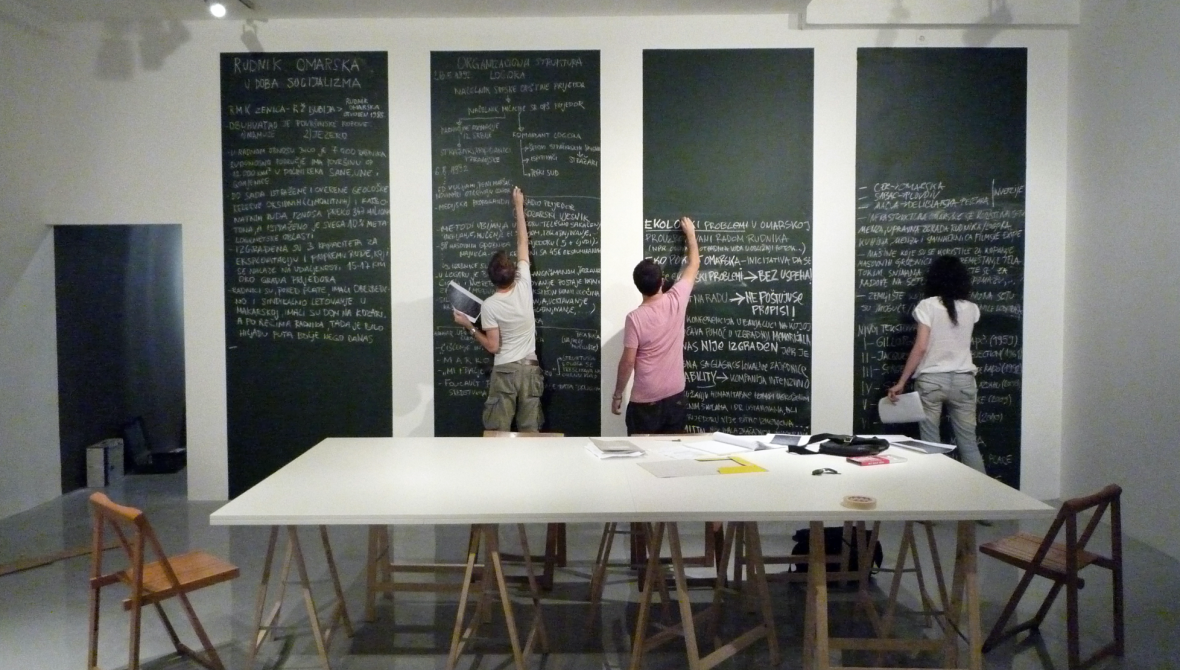On Investigative Memorialization

(Photo credit: Film machine, Amina Abazović, Anousheh Kehar, Hilette Lindeque, Melissa Muhri, Alisa Pekić, Andrea Peković, students at IZK Institute for Contemporary Art, Faculty of Architecture, University of Technology, October 2017, Graz.)
In April 2021 Radar worked with the curator Lívia Páldi to host a screening of and 'public montage session' around Milica Tomić's ongoing video work Four Faces of Omarska: Open Video Sequence, in collaboration with the AHRC Research Network 'Interdisciplinary perspectives in transitional justice', led by Cristian Tileaga of Loughborough University's Department of Communication and Media. The film employs a method that Tomic refers to as 'investigative memorialization'. Below, Paldi explores what this entails.
Coined by Tomić in relation to Four Faces of Omarska: Open Video Sequence, the concept of 'investigative memorialization' is defined as a non-commemorative, transdisciplinary and collective approach to memorialization. Taking distance from the forced and frozen reconciliation of conflicted sides, it understands that any act of memorialization cannot be a static stating of the facts. Four Faces of Omarska is an ongoing art project and platform questioning the strategies of memorial production from the position of those whose experience and knowledge has been subjugated, excluded and disqualified. Developed through collective investigation, Four Faces of Omarska explores what has been omitted from public remembrance and public history. Through continuous engagement with a wide network of people, experiences, opinions and discussions, the project centres around three main eras and four faces of the Omarska iron ore mine near Prijedor in northern the Serb-majority Republika Srpska, one of two semi-autonomous entities which make-up Bosnia and Herzegovina.
Beginning with the operation of the Omarska mining complex during socialist Yugoslavia, the research extends to the concentration camp run by Bosnian Serb forces on its premises, where the mass killing and torture of Yugoslav Muslims and Croats took place during the Yugoslav Civil War of the 1990s. Following the war, the mine complex was taken over in 2004 by ArcelorMittal, one of the world’s largest multinational steel and mining corporations. In 2007, it served as the filming location for the historical ethno-blockbuster St. George Slays the Dragon (Sveti Georgije ubiva aždahu), a Serbian film production.
The locating of mass graves in 2004 and excavations during 2006 opened a new phase of controversy, not only around accessing of the site (for survivors and families of the victims); but around forced reconciliation; the construction of a memorial; as well as how, decades after the Yugoslav civil war, the new states rest on neoliberal economic policies (massive privatization) tied in with nationalism, clerical interventions into state and public affairs, weak sovereignty, poverty, and increasing class divisions.
Featuring invited guests, the public montage and discussion session will address the mutual discontinuities and continuities of the history of the Omarska site as a means of surveying the demise of socialist Yugoslavia and the Yugoslav society. With a specific focus on the privatisation process and transition from societal property socialism to capitalism, the session will also discuss the theoretical, methodological and practical challenges of presenting visual documentation of collective investigative processes. Those present will be invited to participate in this process, with various contributions subsequently being added to the existing 'open video sequence' through future iterations of the work.
Lívia Páldi worked as Curator of Visual Arts at Project Arts Centre, Dublin between March 2017 and March 2021. She was the director of BAC – Baltic Art Center, Visby, Sweden between 2012 and 2015 and chief curator of the Műcsarnok / Kunsthalle Budapest between 2007 and 2011. She has organised talks, discussions, workshops and numerous exhibitions and has also edited several books and exhibition catalogues. She was one of the curatorial agents of dOCUMENTA (13) and member of the OFF-Biennale Budapest curatorial board in 2016. In 2017 she initiated the project Active Archive – Slow Institution, a major research project with exhibitions and events that delves into Project’s rich 50+year history, uncovering the history (or rather histories) of and related to one of Ireland’s oldest public art institutions.
Project Partners
Related Events
Four Faces of Omarska: Open Video Sequence, Public Montage #1
Wed 28 April
18:00pm - 20:00pm
An online event structured around Milica Tomić's video work Four Faces of Omarska, using collectivity to resist fixed memorialization. Read more
Related Projects
Four Faces of Omarska: Open Video Sequence
An online screening and 'public montage' event structured around Milica Tomić's video work Four Faces of Omarska: Open Video Sequence. Read more

